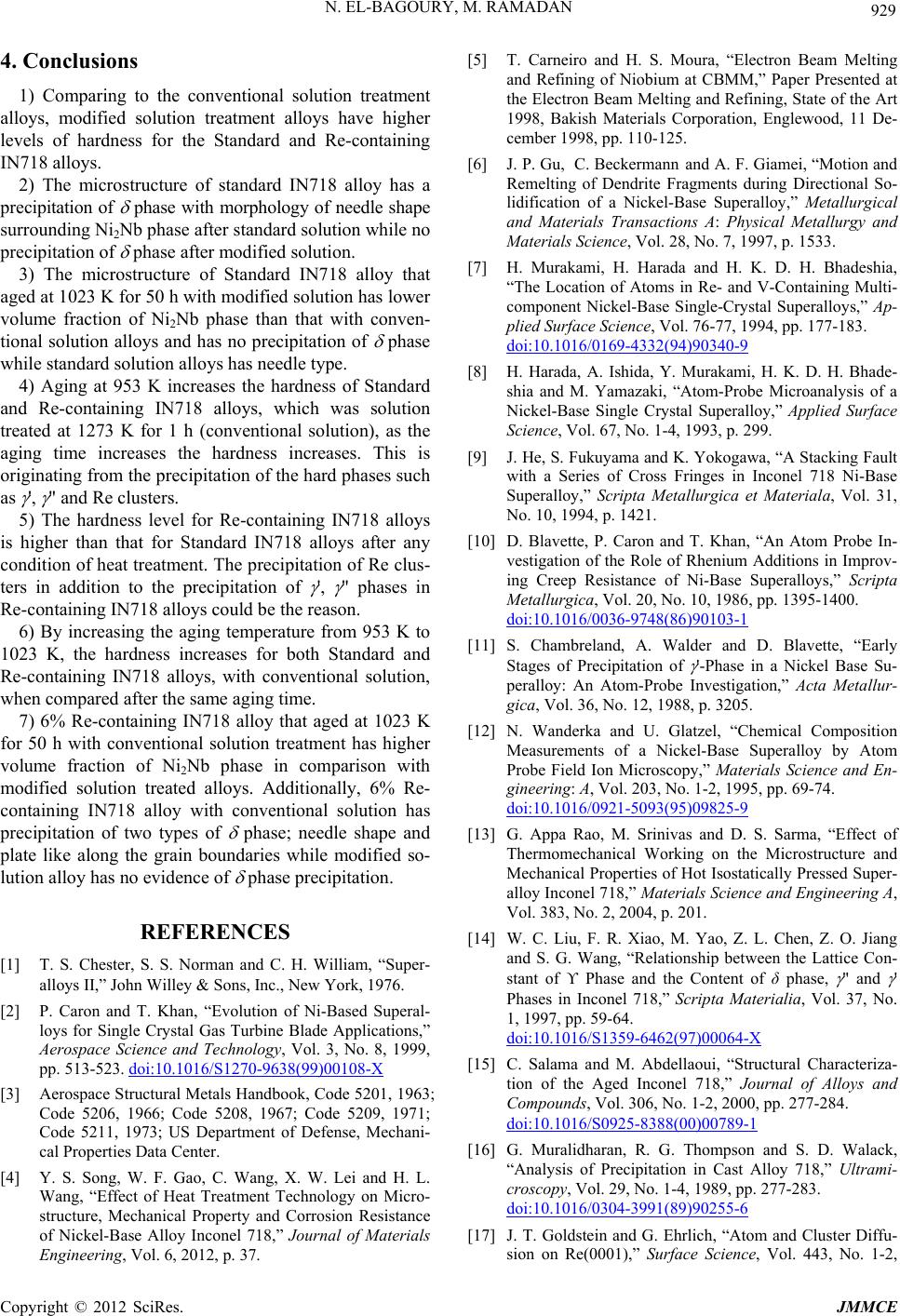
N. EL-BAGOURY, M. RAMADAN 929
4. Conclusions
1) Comparing to the conventional solution treatment
alloys, modified solution treatment alloys have higher
levels of hardness for the Standard and Re-containing
IN718 alloys.
2) The microstructure of standard IN718 alloy has a
precipitation of
phase with morphology of needle shape
surrounding Ni2Nb phase after standard solution while no
precipitation of
phase after modified solution.
3) The microstructure of Standard IN718 alloy that
aged at 1023 K for 50 h with modified solution has lower
volume fraction of Ni2Nb phase than that with conven-
tional solution alloys and has no precipitation of
phase
while standard solution alloys has needle type.
4) Aging at 953 K increases the hardness of Standard
and Re-containing IN718 alloys, which was solution
treated at 1273 K for 1 h (conventional solution), as the
aging time increases the hardness increases. This is
originating from the precipitation of the hard phases such
as
',
" and Re clusters.
5) The hardness level for Re-containing IN718 alloys
is higher than that for Standard IN718 alloys after any
condition of heat treatment. The precipitation of Re clus-
ters in addition to the precipitation of
',
" phases in
Re-containing IN718 alloys could be the reason.
6) By increasing the aging temperature from 953 K to
1023 K, the hardness increases for both Standard and
Re-containing IN718 alloys, with conventional solution,
when compared after the same aging time.
7) 6% Re-containing IN718 alloy that aged at 1023 K
for 50 h with conventional solution treatment has higher
volume fraction of Ni2Nb phase in comparison with
modified solution treated alloys. Additionally, 6% Re-
containing IN718 alloy with conventional solution has
precipitation of two types of
phase; needle shape and
plate like along the grain boundaries while modified so-
lution alloy has no evidence of
phase precipitation.
REFERENCES
[1] T. S. Chester, S. S. Norman and C. H. William, “Super-
alloys ,” John Willey & Sons, Inc., New York, 1976.
[2] P. Caron and T. Khan, “Evolution of Ni-Based Superal-
loys for Single Crystal Gas Turbine Blade Applications,”
Aerospace Science and Technology, Vol. 3, No. 8, 1999,
pp. 513-523. doi:10.1016/S1270-9638(99)00108-X
[3] Aerospace Structural Metals Handbook, Code 5201, 1963;
Code 5206, 1966; Code 5208, 1967; Code 5209, 1971;
Code 5211, 1973; US Department of Defense, Mechani-
cal Properties Data Center.
[4] Y. S. Song, W. F. Gao, C. Wang, X. W. Lei and H. L.
Wang, “Effect of Heat Treatment Technology on Micro-
structure, Mechanical Property and Corrosion Resistance
of Nickel-Base Alloy Inconel 718,” Journal of Materials
Engineering, Vol. 6, 2012, p. 37.
[5] T. Carneiro and H. S. Moura, “Electron Beam Melting
and Refining of Niobium at CBMM,” Paper Presented at
the Electron Beam Melting and Refining, State of the Art
1998, Bakish Materials Corporation, Englewood, 11 De-
cember 1998, pp. 110-125.
[6] J. P. Gu, C. Beckermann and A. F. Giamei, “Motion and
Remelting of Dendrite Fragments during Directional So-
lidification of a Nickel-Base Superalloy,” Metallurgical
and Materials Transactions A: Physical Metallurgy and
Materials Science, Vol. 28, No. 7, 1997, p. 1533.
[7] H. Murakami, H. Harada and H. K. D. H. Bhadeshia,
“The Location of Atoms in Re- and V-Containing Multi-
component Nickel-Base Single-Crystal Superalloys,” Ap-
plied Surface Science, Vol. 76-77, 1994, pp. 177-183.
doi:10.1016/0169-4332(94)90340-9
[8] H. Harada, A. Ishida, Y. Murakami, H. K. D. H. Bhade-
shia and M. Yamazaki, “Atom-Probe Microanalysis of a
Nickel-Base Single Crystal Superalloy,” Applied Surface
Science, Vol. 67, No. 1-4, 1993, p. 299.
[9] J. He, S. Fukuyama and K. Yokogawa, “A Stacking Fault
with a Series of Cross Fringes in Inconel 718 Ni-Base
Superalloy,” Scripta Metallurgica et Materiala, Vol. 31,
No. 10, 1994, p. 1421.
[10] D. Blavette, P. Caron and T. Khan, “An Atom Probe In-
vestigation of the Role of Rhenium Additions in Improv-
ing Creep Resistance of Ni-Base Superalloys,” Scripta
Metallurgica, Vol. 20, No. 10, 1986, pp. 1395-1400.
doi:10.1016/0036-9748(86)90103-1
[11] S. Chambreland, A. Walder and D. Blavette, “Early
Stages of Precipitation of
'-Phase in a Nickel Base Su-
peralloy: An Atom-Probe Investigation,” Acta Metallur-
gica, Vol. 36, No. 12, 1988, p. 3205.
[12] N. Wanderka and U. Glatzel, “Chemical Composition
Measurements of a Nickel-Base Superalloy by Atom
Probe Field Ion Microscopy,” Materials Science and En-
gineering: A, Vol. 203, No. 1-2, 1995, pp. 69-74.
doi:10.1016/0921-5093(95)09825-9
[13] G. Appa Rao, M. Srinivas and D. S. Sarma, “Effect of
Thermomechanical Working on the Microstructure and
Mechanical Properties of Hot Isostatically Pressed Super-
alloy Inconel 718,” Materials Science and Engineering A,
Vol. 383, No. 2, 2004, p. 201.
[14] W. C. Liu, F. R. Xiao, M. Yao, Z. L. Chen, Z. O. Jiang
and S. G. Wang, “Relationship between the Lattice Con-
stant of ϒ Phase and the Content of δ phase,
" and
'
Phases in Inconel 718,” Scripta Materialia, Vol. 37, No.
1, 1997, pp. 59-64.
doi:10.1016/S1359-6462(97)00064-X
[15] C. Salama and M. Abdellaoui, “Structural Characteriza-
tion of the Aged Inconel 718,” Journal of Alloys and
Compounds, Vol. 306, No. 1-2, 2000, pp. 277-284.
doi:10.1016/S0925-8388(00)00789-1
[16] G. Muralidharan, R. G. Thompson and S. D. Walack,
“Analysis of Precipitation in Cast Alloy 718,” Ultrami-
croscopy, Vol. 29, No. 1-4, 1989, pp. 277-283.
doi:10.1016/0304-3991(89)90255-6
[17] J. T. Goldstein and G. Ehrlich, “Atom and Cluster Diffu-
sion on Re(0001),” Surface Science, Vol. 443, No. 1-2,
Copyright © 2012 SciRes. JMMCE